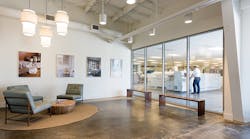Across job functions and industries, discussions, training and collaboration in the workplace are an important aspect of business. When updating a shared office space, envisioning how you will use it will help you decide what shape it takes in a redesign.
When planning to design a shared workspace, it’s important to think about the diversity of employees and provide a variety of spaces for work methods and preferences, advises Patrick Planeta, principal, Planeta Design Group.
A variety of spaces – open and enclosed meeting rooms, conferences rooms and other areas – allows for a more engaging and collaborative company culture.
Don’t overlook details that can increase productivity and group work sessions, and that make spaces special.
“People naturally react differently to different types of furniture, lighting, graphics, etc.,” notes Marisa Anderson, marketing manager for Tangram Interiors. “Providing various types of new furnishings can completely change the way the space is used.”
Providing room and resources for employees to work how it best suits them or their task will help with collaboration. When renovating, keep these tips in mind to increase productivity.
- Make the space multifunctional. Set up large rooms so they can be reconfigured and used in different ways. “If you just put lunch tables and stacking chairs in a space, it will only be used as a lunch area,” says Michael Sinkew, design director and senior associate for Ted Moudis Associates. “If you combine those tables with some booths that … get into a more intimate setting, then it can start to support smaller group meetings that don’t necessarily need a conference room.”
- Create flexibility within a space. Encourage collaboration with furniture that can be easily moved and can serve a variety of functions. The more ways a single space can be used, the more often it will be used.
- Provide tools that will help people do their job. Consider technology needs, including proper outlets, hookups and AV equipment. “Spaces that lack this equipment may be underutilized, or not utilized at all, because these tools are essential to the completion of many tasks,” says Sarah Ross, director of corporate services at Dyer Brown.
Luxury textile company Matouk undertook a renovation of its corporate headquarters in Massachusetts, which is home to a manufacturing floor, administrative spaces and retail area. To accommodate employees, production partners and customers, CambridgeSeven created a design that provides privacy, collaboration and communication.
Collaborative spaces were a key to the redesign, which helped shift the overall company culture to be a more collaborative and creative environment.
The One Kings Lane headquarters serves a variety of creative professionals. Collaboration is a key aspect of the workday at One Kings Lane, and the space provides a broad range of meeting areas of varying sizes, privacy levels, degrees of flexibility and formal/informal characters.
These include large, glass-wrapped conference rooms, quirky individualized booths and informal meeting zones interspersed within the main open office area.
To suit the particular needs of the employees at One Kings Lane, a variety of work and meeting zones were designed that catered to their specific requirements. Two large, daylit open office areas — ideal for creative collaboration — occupy the southeast and southwest corners of the floor in a space that was previously dark.
PLANETA DESIGN GROUP
Planeta Design Group was tasked to completely revamp the investment firm space into a more modern work environment, improve the outdated working conditions for the staff, and create a better sense of community through design. Through the creation of neighborhoods for employees in various departments and areas for collaboration, a variety of spaces was created. This layout was much more conducive to both internal collaboration as well as inviting interviewees and clients in for meetings.
“By expanding the layout in this way, we gave employees more of their own space for privacy and collaboration, encouraging creativity and productivity,” notes Patrick Planeta, principal of Planeta Design Group.
Tangram Interiors needed a space that incorporated the most cutting-edge workplace trends and also acted as a showroom for the many markets it services. The interior solutions provider included a variety of furniture in the update of its own space.
“Providing various types of new furnishings can completely change the way the space is used,” says Marisa Anderson, marketing manager for Tangram Interiors. “Changing lighting can make a space feel more open and inviting or more conducive for a working environment. Graphics can do the same or make it clear as to what a space is supposed to be used for by literally telling users.”
TANGRAM
Flexibility and freedom was key in Tangram’s office design. It was important to have room for education and training.
“Our intention was to demonstrate that eclectic and unexpected furniture can still be planned and allocated to drive performance,” says Anderson. “We firmly believe in providing our employees with the choice and control to work in any area or posture they feel best supports the work they need to accomplish.”
At eBay’s Silicon Valley campus, the company strived to create a media-rich hub where employees are tuned into the company’s everyday business. To do this, eBay relied heavily on interactive digital installations that can display the company’s day-to-day progress at the touch of a screen.
“The centerpiece is a 15-foot touchscreen wall where employees and visitors can tap icons representing cars, shoes, handbags and other goods to see how many items were sold in that category in the past few hours or days,” says Emily Webster, senior designer and AV Technologist at ESI Design.
ANDY RYAN | DYER BROWN
For the Boston headquarters of True Fit, a personalization platform for apparel and footwear, the design team sought to reuse as much of the existing space and materials as possible to create a stylish and creative work environment.
“We adapted existing private office spaces and repurposed them as huddle rooms, reinforcing True Fit’s culture of teamwork and connection,” says Deniz Ferendeci, director of asset design + support at architectural firm Dyer Brown.
For Fresenius Medical Corporation’s Boston area workplaces, the goal was to open up offices. Departments used to be segregated and siloed, and there were no central hubs for employees to interact.
“The new workplace concept for Fresenius encourages collaboration and interaction by reorganizing workspaces into ‘neighborhoods’ with one of three types of conveniently located collaboration spaces serving as a hub for each,” says Sara Ross, director of corporate services at Dyer Brown. “The types are referred to as impromptu (designed for spontaneous conversations), AV (integrating technology for conferencing and presentations) and whiteboard (ideal for team-based problem-solving).”
DARRIN HUNTER | DYER BROWN
Employees at Fresenius with tech issues have a much more hospitable environment to alleviate their issues. The IT Clinic, the company’s tech support helpdesk, resembles a retail IT helpdesk like the Apple Genius Bar.
“Employees bring their software and hardware issues in person rather than by phone, which elevates the visibility of the IT department while presenting yet another space for informal interaction, collaboration and problem-solving,” explains Sara Ross, Director of Corporate Services at Dyer Brown. “The solution reinforces a culture of teamwork and common purpose, and also supports a more active workplace.”
The boardroom at AAA’s Northern California headquarters in Emeryville, CA, echoes the company’s roadside assistance mission with a textured ceiling that resembles tire tracks and a table showcasing vintage hubcaps.
One of the goals for the project was “creating the spirit that a group has while making a road trip together,” explains Melissa Pesci, principal and vice president at HGA Architects and Engineers, which designed the 50,000-square-foot space. “The space was designed to be the embodiment of the excitement, inspiration, curiosity and exploration that occur when a group of people come together to embark on an adventure.”
JASPER SANIDAD
Even the individual workstations at AAA are built to support collaboration, Pesci explains. The shelving units stashed under the desks are upholstered on top to create comfortable perches for colleagues.
On topic: The Amenities Tenants Really Want
“AAA has an amazing retention rate, but many of the employees move between departments as they develop in their careers and as the company evolves,” Pesci says. “Thus, it was important that all of the workstations be the same but offer enough flexibility to accommodate the different types of work at AAA as well as accommodate both focus work, privacy and collaboration.”
Collaboration is central to the company culture at Alphasights, where small huddle spaces like this create intimate settings for small meetings. The curvilinear shapes create a dynamic and energetic feel perfect for an information services company.
AvalonBay Communities, a publicly traded real estate investment trust, needed a flexible new workspace that reflected its brand and culture and encouraged collaboration.
The company was committed to ensuring that all of the workspace and common areas had visual access to Boston Harbor on the south side of the building and downtown Boston on the north, allowing for plenty of natural light to stream into the efficient floor plan. Glass offices help daylight penetrate further into the office.
BRENT GOLLNICK
NASCAR’s sleek New York City office pays tribute to the company’s heritage without looking “museum-like,” explains Michael Sinkew, design director and senior associate for Ted Moudis Associates, the firm that designed the 14,700-square-foot space for the racing titan.
Read also: LED vs. Induction Lighting
“We worked closely with graphic providers to create these custom wallcoverings to add not only color and vibrancy to the space, but also reinforce the brand,” Sinkew says. The branding effort impacts even the naming of conference rooms (inset).
Wilton Brands, a historic baking and food decorating company, condensed a four-building campus into a single 86,111-square-foot location spread over two floors. The new all-in-one destination houses everything from general office space to sophisticated test kitchens and needed a cohesive design to bring it all together.
“We reduced the quantity of private offices and created much more of an open office collaborative space with a lot of different destinations for collaboration, whether that be in the open area space, conference rooms or individual phone rooms,” explains Janice Fellows, Senior Associate and Design Director for Ted Moudis Associates.
GARRETT ROWLAND
Mediabrands, a global marketing agency, needed a brighter space that could facilitate the move to activity-based working with no assigned seating, but the floor that the company was moving into needed work.
“The architectural volumes and shapes were good, but they weren’t highlighted and needed definition,” explains Jeff Knoll, senior associate and design director for Ted Moudis Associates. “The high ceilings were a plus, but the vast open areas resembled a sea of desks without any scale or visual interest.”
The design team used bold swaths like this to provide visual cues and wayfinding to staff, as well as define space into separate neighborhoods (a key feature of the free-address workstyle) and reduce scale. Each neighborhood uses large patches of colored carpet, such as this bright red one, to house alternate work areas like soft seating and work counters.
Wallcoverings, tile, paint, drapery, graphics, and even fur, rope and ceramics further customized individual neighborhoods and created a playful office environment perfect.
Before renovation, software company Enthought’s space didn’t meet its needs. It was dated, dark and compartmentalized. The new design opened up the office, letting light in and providing spaces for collaboration.
“There are multiple work pods dispersed throughout the suite with room for team interactions and brainstorming, and glass walls that double as markerboards,” says Samantha Davila, Interior Designer at Perkins+Will (previously lauckgroup).
For software development company Informatica, it was important to provide a multiple types of spaces that facilitate different levels of teamwork.
“Communal areas throughout the space take center stage and address the many needs of employees with a broad range of workplace preferences,” says Joe Gowing, Principal at Perkins+Will (previously lauckgroup). “From one large, centrally located break room to smaller cafe and meeting areas, there are numerous options for impromptu team meetings or workspace away from their assigned desks.”
Telecommunications company Securus has a central collaboration zone that spans the axis of the entire building. As Securus has grown, this area has become a more integral part of the facility.
“We were able to maintain this buffer of breakout space to support occupants’ well-being and creativity,” says Sara Barnes, project designer at Perkins+Will (previously lauckgroup). “This feature was critical because of the number of employees operating out of one building and their company goal to connect employees to foster innovation.”
Two hand-picked articles to read next:



